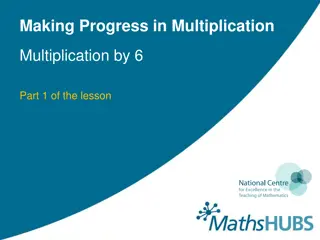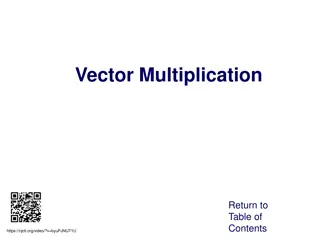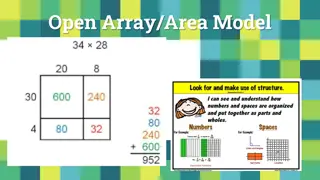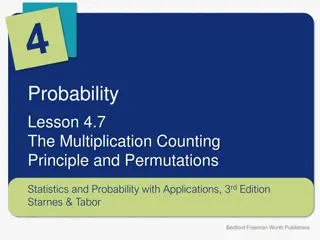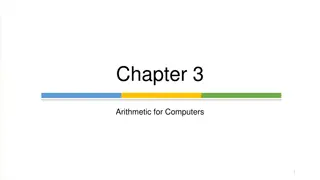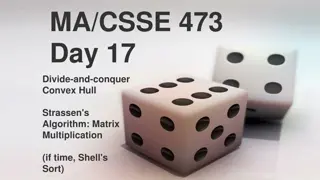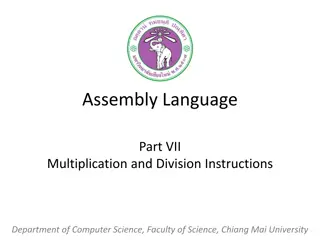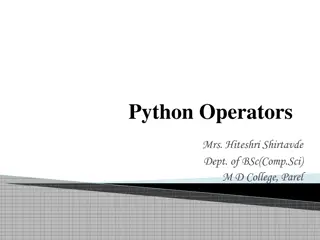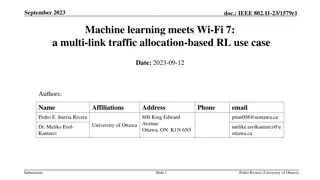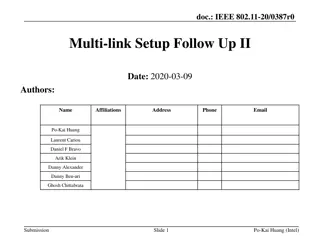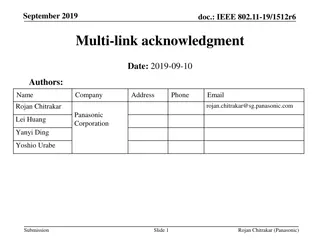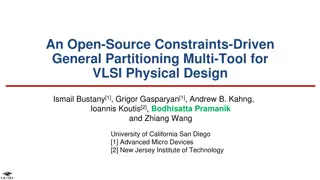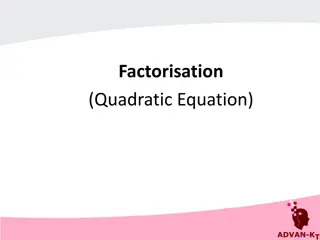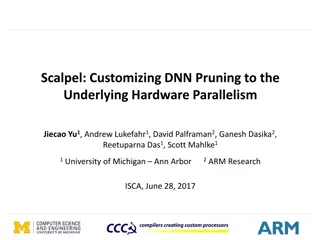Optimizing Multi-Scalar Multiplication Techniques
Delve into the world of optimizing multi-scalar multiplication techniques with a focus on improving performance, especially in Zero Knowledge Proofs systems using elliptic curves. Explore algorithmic optimizations like the Bucket Method by Gus Gutowski and learn about the runtime breakdown, motivations, and practical applications. Discover practical insights and strategies for enhancing the efficiency of multi-scalar multiplication computations.
- Optimization Techniques
- Multi-Scalar Multiplication
- Zero Knowledge Proofs
- Algorithmic Optimization
- Gus Gutowski
Download Presentation

Please find below an Image/Link to download the presentation.
The content on the website is provided AS IS for your information and personal use only. It may not be sold, licensed, or shared on other websites without obtaining consent from the author. Download presentation by click this link. If you encounter any issues during the download, it is possible that the publisher has removed the file from their server.
E N D
Presentation Transcript
A deep dive into optimizing Multi-Scalar Multiplication By Niall Emmart nemmart@yrrid.com
Talk Roadmap Introductory Material Algorithmic Optimizations Bucket Method and Gus Gutowski s talk GPU Implementation WebAssembly (WASM) Implementation Multiple Precision Integer Representations
Multi-Scalar Multiplication (MSM) Given a cyclic group G, and n group elements, G1, ,Gnand n integers values, s1, ,snbetween 0 and |G|, compute: MSM = s1G1+ s2G2+ + snGn
Motivation: Zero Knowledge Proofs Many ZKP systems use MSM over elliptic curves on finite fields, in particular the BLS and BN curves. Group elements are points on the curve. |G| is the main subgroup order. MSM is very compute heavy Represents 80-90% of the total runtime to generate a proof in some ZKP systems. GOAL: Improve MSM performance
MSM Runtime Breakdown total run time = Overhead + # of FF ops Average time per FF op Typically small, 10-20% of total run time. Driven by high level algs and EC point representation Dominated by FF multiplication time FF op = Finite Field Op: add, sub, multiplication, inverse
Bucket Method (Pippengers Alg) In Brief The Bucket method computes an MSM in three phases: 1. Bucket accumulation 2. Bucket reduction to window sums 3. Final MSM computation Gus Gutowski s Talk YouTube link: https://www.youtube.com/watch?v=Bl5mQA7UL2I
Bucket Method (Pippengers Alg) In Brief b bits in length si = . . . c bits chunks c bits ? ? Number of chunks aka windows is: w = Notation: n number of pts & scalars w the number of windows b bit length of the scalar i a point/scalar index, 1 .. n c window chunk size in bits j a window index, 0 .. w-1 k a bucket index, 0 .. 2c-1 si[j] value of the jth chunk of si B[j, k] accumulator bucket
Bucket Accumulation Phase Pseudo-Code for bucket accumulation: initialize all buckets to 0 for(i=1;i<=n;i++) { for(j=0;j<w;j++) B[j, si[j]] += Pi; } Things of note: Total numbers of buckets is w 2c 1) 2) Each point is added to w buckets 3) Total number of point adds is w n
Bucket Reduction Phase For each window j, we compute: 2? 1 ??= ? ?[?,?] ?=1 Wj can be efficiently computed using the sum of sums algorithm: sum = 0; sumOfSums = 0; for(k=2c-1;k>0;k--) { sum += B[j, k]; sumOfSums += sum; } Wj = sumOfSums;
Final MSM Result Once the Wj value for each window has been computed, we compute the final MSM value as follows: ? 1 2?? ?? ??? = ?=0 Which can be efficiently computed as follows: MSM = 0; for(int j=w-1;j>=0;j--) MSM = 2c * MSM + Wj; return MSM;
Signed Digits Endomorphism Since we can efficiently compute -Pi [instead of (x, y) it s just (x, -y)], we can preprocess the scalars as follows and cut the number of bucket accumulators in half: for(int i=1;i<=n;i++) { for(int j=0;j<w;j++) { if(si[j]>2c/2) { si[j]=2c-si[j]; si[j+1]++; // instead of adding Pi, we add Pi to B[j, si[j]] } } } Requires that c does not evenly divide b
Cube Root of One Endomorphism The BLS curves have a cube root endomorphism. It is best explained with an example curve. Some of the BLS12-381 Curve Parameters Field Modulus q 0x1a0111ea397fe69a4b1ba7b6434bacd764774b84f38512bf6730d2a0f6b0f6241ea bfffeb153ffffb9feffffffffaaab Field Order (|G|) 0x73eda753299d7d483339d80809a1d80553bda402fffe5bfeffffffff00000001 beta ( 3 = 1 mod q) 0x1a0111ea397fe699ec02408663d4de85aa0d857d89759ad4897d29650fb85f9b40 9427eb4f49fffd8bfd00000000aaac lambda ( 3 = 1 mod |G|) 0xac45a4010001a40200000000ffffffff For every BLS12-381 point, P=(x, y), the exists another point, ?, where ? = (??,?) = ??. Thus we can re-express any point and scalar pair, ??, where ? ? and ? = ?,? as: ?? = ?1 ? + ?2? = ?1??,? + ?2? where s1= s div ?,?2= ? mod ?, and we have both ?1,?2< 2128. The smaller s1 and s2 scalars can improve performance in some cases.
Two Open Questions 1. Can we extract more conflict free parallel work? 2. Can we efficiently use signed digits when c evenly divides b?
Algorithmic Optimizations GPU Implementation
ZPrize GPU MSM Competition 1. Generates 2^26 random points (BLS12-377, on the CPU) 2. Allowed to copy points to GPU memory and do limited untimed precomputation on the points 3. Generates 4 sets of 2^26 scalars (on the CPU) 4. Timer starts 5. Minimize the time to compute 4 MSM values, corresponding to the 4 scalars sets against the point set. 6. A40 GPU (48 GB GPU mem).
Extract Parallelism To achieve maximum efficiency on the GPU requires tens of thousands of threads running in parallel. Q: How can we extract that much parallelism? A: Simple, instead of looping over the points, adding each Pi to w buckets, we use sorting to build lists of the points to be added to each bucket. Then we process those lists in parallel, one thread per bucket.
Bucket Accumulator Point Representation Accumulation Phase: Representation Second Addition Third (and up) Addition Jacobian: XYZ += XY 4 modmul, 2 modsqr (6 mults) 7 modmul, 4 modsqr (11 mults) Extended Jacobian: XYZZ += XY 4 modmul, 2 modsqr (6 mults) 8 modmul, 2 modsqr (10 mults) 5 modmul, 1 modsqr (6 mults) 5 modmul, 1 modsqr (6 mults) Batched affine addition: XY += XY Reduction Phase: Representation Second (and up) Addition Jacobian: XYZ += XYZ 11 modmul, 5 modsqr (16 mults) Extended Jacobian: XYZZ += XYZZ 12 modmul, 2 modsqr (14 mults) 5 modmul, 1 modsqr (6 mults) Batched affine addition: XY += XY From: https://www.hyperelliptic.org/EFD/g1p/auto-shortw.html Requires batched addition discussed later in the talk
Best Window Size? Table of mod-mul counts: BLS12-377, thus b=253: Without signed digits With signed digits Size Acc Phase Red Phase Total Acc Phase Red Phase Total Using Trick c=21 8.04 0.70 8.74 8.38 0.35 8.73 c=22 7.41 1.29 8.70 7.73 0.65 8.38 c=23 6.09 2.58 8.67 7.07 1.29 8.36 8.03 c=24 5.03 4.70 9.73 6.21 2.35 8.56 All counts in billions of modmuls per MSM When c=23, c evenly divides b (23*11=253)
Trick: sP = (-s)(-P) Can we efficiently handle signed digits in the case where c evenly divides b? This is the case for b=253 and c=23! Na ve solution: create an extra window to handle the scalars where the msb is set. Better solution: Note, sP = (-s)(-P) Proof: (-s)(-P) = (|G| - s)(-P) = |G|(-P) - (s(-P)) = 0 - (s(-P)) = 0 + sP = sP When the msb of si is set we can negate both the scalar and point, and the msb of -si will be clear. This trick saves us approx. 335 million modmuls.
Precomputed Points For each Pi, we precompute 5 other points: 246Pi , 292Pi , 2138Pi , 2184Pi , 2230Pi. Adding 246Pi to window 0 is equivalent to adding Pi to window 2. Thus, we can reduce the 11 windows down to 2. Final count, 7.50 billion modmuls Wasn t able to exploit the cube root endomorphism
Parallel Bucket Reduction 2? 1? ?[?, ?] Bucket reduction: ??= ?=1 Need a massively parallel algorithm for the GPU. Consider a simple example with j=0, c=3, with 3 threads: ?0= 1 ?1+ 2 ?2+ 3 ?3+ 4 ?4+ 5 ?5+ 6 ?6+ 7 ?7+ 8 0 + 9 0 Thread 0 Thread 1 Thread 2 1. Assign q consecutive buckets to each thread (in this case 3 buckets), and pad with 0 values 2. Each thread t computes the sum, St and the sum-of-sums, SOSt for its buckets W0 can now be computed from St and SOSt as follows: 3. 2 2 ?0= ? ? ??+ ???? ?=1 ?=0 Shorthand notation: Bi = B[0, i]
Correction-less EC Point Routines For some curves and operations, in particular BLS12-377, XYZZ + affine point, implemented using Montgomery multiplication, we can build correction-less versions. Process to add an affine point (X2, Y2) to an XYZZ (X1, Y1, ZZ1, ZZZ1) accumulator: U2 = X2 * ZZ1; S2 = Y2 * ZZZ1; P = U2 X1; R = S2 Y1; PP = P2; PPP = P * PP; Q = X1 * PP; X3 = R2 (PPP + 2*Q); Y3 = R * (Q-X3) Y1 * PPP; ZZ3 = ZZ1 * PP; ZZZ3 = ZZZ1 * PPP; return (X3, Y3, ZZ3, ZZZ3); From https://www.hyperelliptic.org/EFD/g1p/auto-shortw-xyzz.html#addition-madd-2008-s
Correction Steps Correction steps are often needed to ensure that the result of a finite field operation remains in the valid range, [0, N), where N is the field prime modulus. For example: BigNum add(BigNum A, BigNum B) { BigNum S=A+B; if(S>=N) // correction step S=S-N; } BigNum sub(BigNum A, BigNum B) { BigNum D=A-B; if(D<0) // correction step D=D+N; } BigNum mul(BigNum A, BigNum B) { BigNum R=redc(A*B); if(R>=N) // correction step R=R-N; } GOAL: get rid of correction steps!
Bounds We will ensure three properties: 1) Every intermediate value will be positive (>= 0) 2) Every intermediate value will have an upper bound 3) The bounds are stated in terms of multiples of N, e.g., X in [0, 3.4] means 0<=X<=3.4N. Operations: addBound(aBound, bBound) => aBound + bBound subBound(aBound, bBound) => aBound + ceil(bBound) montMulBound(aBound, bBound) => (aBound*bBound/152) + 1 This bound is specific to BLS12-377. Proof on next slide.
Bounds for Montgomery Multiplication From Montgomery s original paper, we have: MontMul(BigNum A, BigNum B) = (A*B + Q*N) / R (for some 0<=Q<R, where R=2384). Rewrite in terms of aBound and bBound: MontMul(aBound*N, bBound*N) < (aBound*bBound*N*N + R*N)/R < N*(aBound*bBound/(R/N) + 1) [ for BLS12-377, R/N>152, thus ] < (aBound*bBound/152 + 1)*N We state the bounds in terms of multiples of N, therefore: montMulBound(aBound, bBound) = (aBound*bBound/152) + 1 Note, montMulBound(7.4, 8.3) = 1.41, is considerably smaller than 7.4 or 8.3. Contrary to what one might expect, MontMul shrinks the bounds!
Correction-less EC Algorithms Process to accumulate XYZZ (X1, Y1, ZZ1, ZZZ1) an affine points (X2, Y2): // Input asserts / requirements: // X1 <= 6N, Y1 <= 4N, ZZ1 <= 2N, ZZZ1 <= 2N // X2 <= 1N, Y2 <= 1N U2 = X2 * ZZ1; S2 = Y2 * ZZZ1; P = U2 X1 + 6N; R = S2 Y1 + 4N; PP = P2; PPP = P * PP; Q = X1 * PP; X3 = R2 (PPP + 2*Q) + 4N; // 5.02^2/152+1+4 = 5.17 // X3 <= 5.17 N YP = Y1*PPP; // 4*1.07/152+1 = 1.03 // YP <= 1.03 N Y3 = R*(Q - X3 + 6N) YP + 2N; // 5.02*7.03/152+1+2 = 3.24 // Y3 <= 3.24 N ZZ3 = ZZ1 * PP; // 2*1.33/152+1 = 1.02 // ZZ3 <= 1.02 N ZZZ3 = ZZZ1 * PPP; // 2*1.07/152+1 = 1.02 // ZZZ3 <= 1.02 N // 1*2/152+1 = 1.02 // U2 <= 1.02 N // 1*2/152+1 = 1.02 // S2 <= 1.02 N // 1.02 + 6 // P <= 7.02 N // 1.02 + 4 // R <= 5.02 N // 7.02^2/152+1 = 1.33 // PP <= 1.33 N // 7.02*1.33/152+1 = 1.07 // PPP <= 1.07 N // 6*1.33/152+1 = 1.06 // Q <= 1.06 N // Output assertions: // X3 <= 6N, Y3 <= 4N, ZZ3 <= 2N, ZZZ3 <= 2N // Output assertions match input requirements!!
GPU Specific Optimizations Use 384 threads per SM (this requires careful register usage management) Use state machines to avoid thrashing the instruction cache Overlap compute and CPU -> GPU copy using GPU streams Matter Labs: For the first MSM, break it into two MSMs of the size and remaining for better compute/copy overlap.
Algorithmic Optimizations WASM Implementation
ZPrize WASM MSM Competition 1. Generates random MSM problems that range in size from 2^12 to 2^18. 2. Uses BLS12-381, with b=255. 3. Score is the average speed-up of the submitted code over the provided baseline code running on Chrome (v96). 4. No WASM vector ops, only allowed to use a single thread
Approach Bucket method, c is chosen empirically based on MSM size Endomorphisms: signed digits and cube root of one Use the sP=(-s)(-P) trick when c evenly divides b Use batched affine point accumulators for both the accumulator phase and the reduction phase.
Affine Point Accumulation Process to add two affine points (X1, Y1) and (X2, Y2): D = X1 X2; // X1==X2 case requires special processing I = D-1; T = (Y1 Y2) * I; X3 = T2 + X1 + X2; Y3 = T * (X2 X3) Y2; return (X3, Y3); // inverse operation is very expensive Expensive op count: 2 modmul, 1 modsqr, 1 modinv
Batch Inversion Example of inverting a batch of 4: A, B, C, D T0= A B; T1 = T0 C; T2 = T1 D; I = T2-1; D-1 = I T1; I = I D ; C-1= I T0; // C-1 = (ABC)-1(AB) I = I C; B-1= I A; A-1= I B; // T0 = AB // T1 = ABC // T2 = ABCD // I = (ABCD)-1 Note: (ABCD)-1 = A-1B-1C-1D-1 // D-1 = (ABCD)-1(ABC) // I = (ABCD)-1(D) = (ABC)-1 // I = (ABC)-1(C) = (AB)-1 // B-1 = (AB)-1(A) // A-1 = (AB)-1(B) Inverting a batch of n finite fields requires 3n-3 modmul, and one modular inverse.
Batched Affine Accumulator Given a list (i.e., a batch) of tuples (Bucket, Point), iterate over the list, adding the points to the buckets. This algorithm runs in phases: 1. First phase construct the list of values to invert 2. Run the batch invert algorithm 3. Third phase complete the point adds Important caveat: you can t add two points to the same bucket in a batch. Cost: 5 modmuls, 1 modsqr per point add (6 mults) 1 mod inverse per batch
Collision Method Typical implementations generate lists of points for each bucket (essentially sorting). These are used to build conflict free batches. But it is expensive and wanted something more efficient: We have a lock flag for each bucket and a collision list. We process the scalars/points in order. If the target bucket is not locked, we add the point/bucket to the current batch and lock the bucket. If it is locked, we add the point/bucket to the collision list. If we have a full batch, or the collision list reaches its limit, we process the batch and repeat. When we start the next batch we reset the locks and add what we can from the collision list to the new batch. Repeat until all points have been processed and the collision list is empty.
Bucket Reduction Phase The key challenge for the reduction phase is constructing independent batches of adds. Essentially we can use the same strategy we used on the GPU. Break the window sum into smaller sums of size q. ?0= 1 ?1+ 2 ?2+ 3 ?3+ 4 ?4+ 5 ?5+ 6 ?6+ 7 ?7+ 8 0 + 9 0 Group 0 Group 2 Group 1 Since each group is independent of the other groups, each group can provide an add to the batch without conflicts.
Noteworth Contributions Correction-less EC algorithms sP=(-s)(-P) trick for when c evenly divides b Collision method for building batches Batched affine accumulators for the reduction phase
GPU - Basics We represent a BLS12-377 finite field value as a sequence of 12 32-bit limbs (m). The x, y, zz, and zzz finite field values are entirely stored in registers on each thread. Addition and subtraction are linear O(m), approx. 12 instructions each. The modmul operation uses simple O(m^2) algorithms for both the multiplication and the Montgomery reduction. Fully unrolled, approx. 400 instructions in length. Modsqr takes advantage of fast-squaring, approx. 320 instructions. Modmul and modsqr are by far the most expensive ops and must be carefully optimized. Matter Labs optimization: MontRed(a*b) + MontRed(c*d) = MontRed(a*b + c*d) which can save a MontRed step.
GPU IMAD.WIDE Instruction Volta+ GPUs have a 64-bit multiplication instruction: IMAD.WIDE D, A, B, C Computes A*B + C, stores the result in D. A and B are 32 bit source registers. C and D are pairs of even aligned 32-bit registers. Supports optional carry in and optional carry out. Throughput: 128 IMAD.WIDE ops every 4-5 cycles per SM.
Alignment Problem A3 B3 A2 B2 A1 B1 A0 B0 H(A2B0) L(A2B0) H(A0B0) L(A0B0) H(A3B0) L(A3B0) H(A1B0) L(A1B0) H(A2B1) L(A2B1) H(A0B1) L(A0B1) B0 rows H(A3B0) L(A3B0) H(A1B0) L(A1B0) H(A2B1) L(A2B1) H(A0B1) L(A0B1) B1 rows H(A3B1) L(A3B1) H(A1B1) L(A1B1) H(A2B2) L(A2B2) H(A0B2) L(A0B2) H(A3B2) L(A3B2) H(A1B2) L(A1B2) H(A2B3) L(A2B3) H(A0B3) L(A0B3) B2 rows H(A3B2) L(A3B2) H(A1B2) L(A1B2) H(A2B3) L(A2B3) H(A0B3) L(A0B3) B3 rows H(A3B3) L(A3B3) H(A1B3) L(A1B3) odd even odd even odd even odd even
Even-Odd Solution A3 B3 A2 B2 A1 B1 A0 B0 Even aligned terms H(A2B0) L(A2B0) H(A0B0) L(A0B0) H(A3B1) L(A3B1) H(A1B1) L(A1B1) H(A2B2) L(A2B2) H(A0B2) L(A0B2) H(A3B3) L(A3B3) H(A1B3) L(A1B3) odd even odd even odd even odd even aligned accs H(A2B1) L(A2B1) H(A0B1) L(A0B1) H(A3B0) L(A3B0) H(A1B0) L(A1B0) Odd aligned terms H(A3B2) L(A3B2) H(A1B2) L(A1B2) H(A2B3) L(A2B3) H(A0B3) L(A0B3) odd even odd even odd even unaligned accs result = aligned accs + (unaligned accs<<32)
Fast Squaring A3 A3 A2 A2 A1 A1 A0 A0 L(A3A0) H(A2A0) L(A2A0) H(A1A0) L(A1A0) H(A0A0) L(A0A0) H(A3A0) L(A3A1)L(A2A1)L(A1A1) L(A0A1) H(A3A1) H(A2A1)H(A1A1) H(A0A1) L(A3A2) L(A2A2) L(A1A2) L(A0A2) H(A3A2)H(A2A2) H(A1A2) H(A0A2) L(A3A3) L(A2A3) L(A1A3) L(A0A3) H(A3A3) H(A2A3)H(A1A3) H(A0A3) Compute the Red values, double it and add in the grey diagonal values
Key Take-Aways You need a deep understand the underlying hardware architecture, and the available math instructions When possible, write the low level math routines in assembly When not possible, check what the compiler is generating, ensure it s efficient code Try out different algorithms and variants to see which work best
Web Assembly Environment We implemented our submission in C. Work flow: Chrome JS + TurboFan C source clang .wasm JIT: Native x86 JavaScript loads the .wasm, creates and manages the wasm object, handles integration with the web page. TurboFan JITs the .wasm byte code to native x86
WASM - Basics We represent a BLS12-381 finite field value as a sequence of 13 30-bit limbs (m) embedded in 64-bit unsigned ints. WASM byte code does not support the carry flag. Addition and subtraction are fast. Modmul and modsqr are slow. Both use Montgomery multiplication. We use one level of Karatsuba multiplication in modmul, and fast squaring in modsqr.
Multiplication . . . . . . A3 B3 A2 B2 A1 B1 A0 B0 A3B0 A2B1 A2B0 A1B1 A1B0 A0B1 A0B0 A3B1 A3B2 A2B2 A1B2 A0B2 A3B3 A2B3 A1B3 . . . A0B3 The idea behind 30-bit limbs is the multiplier. Consider a column in a 13x13 multiplication. We are guaranteed that we can accumulate 16 Ai Bj terms without needing to worry about overflowing a 64-bit accumulator. The cost of a 13th limb is much less than the cost of resolving the overflows.
Carry Handling - Addition Add routine. Results can have 31 bits of data in each limb. FF381 add(FF381 a, FF381 b) { FF381 res; res.limb0 = a.limb0 + b.limb0; res.limb1 = a.limb1 + b.limb1; res.limb2 = a.limb2 + b.limb2; . . . res.limb12 = a.limb12 + b.limb12; return res; }
Carry Handling - Resolving Carries Resolve any carries that have built up in the limbs: FF381 resolveCarries(FF381 f) { FF381 res; uint64_t mask=0x3FFFFFFF; // 30 bit mask res.limb1 = f.limb1 + (f.limb0>>30); res.limb2 = f.limb2 + (f.limb1>>30); . . . res.limb12 = f.limb12 + (f.limb11>>30); res.limb0 = res.limb0 & mask; res.limb1 = res.limb1 & mask; . . . res.limb11 = res.limb11 & mask; return res; }



